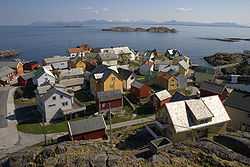Newfoundland outport
- For wider usage of the term outport see Outport.



An outport is the term given for a small isolated coastal community in the Canadian province of Newfoundland and Labrador. Originally the term was just used for coastal communities on the island of Newfoundland but the term has also been adopted for those on the mainland area of Labrador as well.
History
Outports are some of the oldest European settlements in Canada, many of them having been established by Portuguese, Spanish, Basque, French, and English fishermen and whalers in the 16th-19th centuries. Typically, they feature small wooden houses and associated outbuildings and fishing stages clustered around the water's edge. The pattern of small isolated settlements resulted from actions of the Parliament of England to make permanent settlement of Newfoundland illegal. Seventeenth century English fishermen and fish merchants wished to avoid competition from a local population gaining control of the most productive fishing locations as the New England colonies had done in the Gulf of Maine. The questionable legal status of Newfoundland's clandestine settlements discouraged the type of infrastructure investments found in the Maritime Provinces.[1]
The term outport has sometimes been used in a derogatory sense. On the island of Newfoundland, residents of the capital city of St. John's would frequently be referred to as townies, whereas those not from St. John's would be referred to as baymen or bay wops - derived from outport. This cultural phenomenon mostly existed in the days before reliable surface land transportation on the island, when most travel was by boat or coastal ferry and settlements were located on the coast.
The railway construction in the 1890s resulted in the creation of inland communities that relied on land-based natural resources. The outports began to see wholesale depopulation following cutbacks to ferry services and construction of roads throughout the island during and after the Second World War. Following Confederation in 1949, the government of premier Joey Smallwood pursued a policy of forced/encouraged resettlement of residents from outports to central inland communities where provision of schools, health care and other government services could be achieved more cheaply.
The resettlement program had many critics, as they noted that it resulted in what was likened to a "cultural genocide" as rural Newfoundland society became decimated. The cod moratorium of 1992 was another blow to the outport communities, whose entire economies were based on the ocean and its resources. Throughout the 1990s and into the 2000s, outports have voluntarily agreed to depopulate as government required 100% agreement among residents for resettlement, prior to agreeing to close a community. In March 2013, Newfoundland & Labrador Finance Minister Jerome Kennedy announced that households agreeing to resettle from some isolated communities will be given lump-sum payments of up to CAD $270,000.[2]
Only a small proportion of the provincial population remains in outports along the coasts of Newfoundland and Labrador. With no highway access, limited economic growth due to declines in the fishery, and ongoing depopulation as young people move to larger urban centres, the outport is an endangered phenomenon.
A 1969 CBC radio documentary by Canadian pianist Glenn Gould called The Latecomers profiled Newfoundland outports.
See also
- Fishing stage
- Heritage Foundation of Newfoundland and Labrador
- List of communities in Newfoundland and Labrador
Notes
- ↑ Whiteley, George Northern Seas, Hardy Sailors W. W. Norton & Company 1982 p. 30
- ↑ http://www.cbc.ca/news/canada/newfoundland-labrador/story/2013/03/26/nl-resettlement-fund-isolated-communities-326.html

